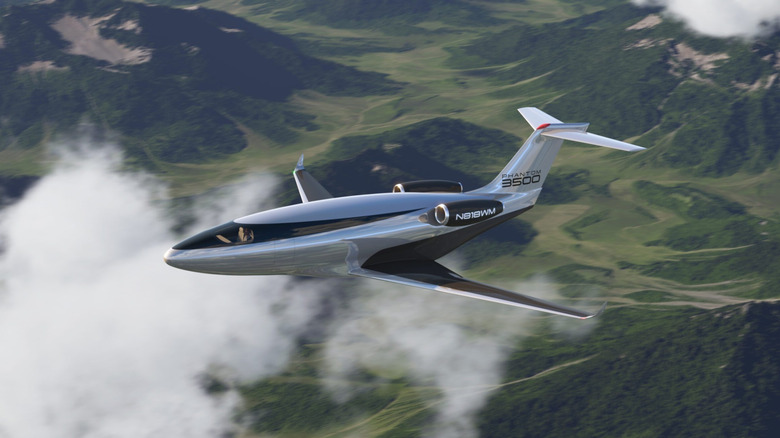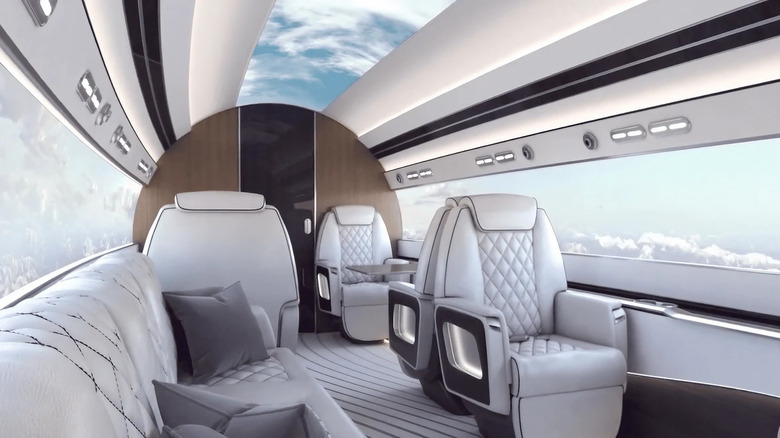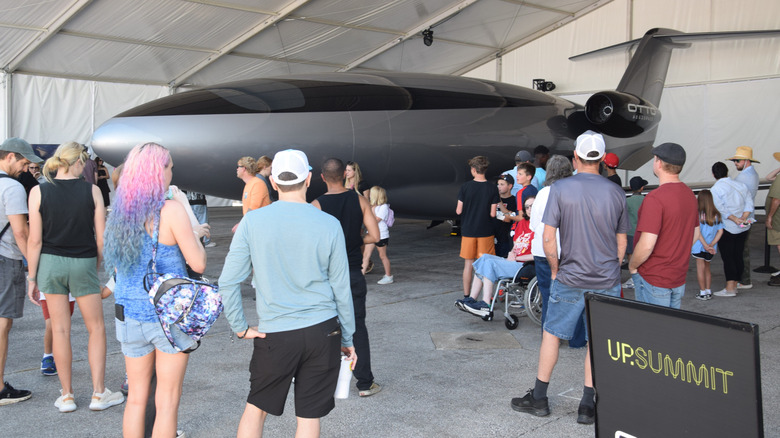This High-Tech Jet Gives Passengers 'SuperNatural Vision' Instead Of Windows
Most of us are willing to pay extra for airplane windows, but engineers aren't fans of them, as windows affect the structural integrity of the hull and create drag. It's one of the reasons why airplane windows are typically tiny. Texas-based Otto Aerospace decided to solve this problem with its futuristic Phantom 3500 jet by getting rid of the passenger windows entirely. Instead, your view outside will be down to a system the company calls "SuperNatural Vision." This is basically a collection of high-resolution digital displays that stretch a massive six feet wide along the cabin walls. On them, you'll get a color-enhanced, panoramic view of the world outside, created by stitching together footage from external cameras. Otto's CEO Paul Touw told the Wall Street Journal the effect is "surreal," promising passengers can see the curvature of the Earth without ever leaving their seats.
Besides the structural benefits, the implementation also will allow the plane to have an unusually aerodynamic fuselage that basically lets air glide over its body like a frictionless liquid. Of course, it also helps that the Phantom 3500's torpedo-shaped body will be built from all-carbon-fiber composites. The design also allows for a cavernous interior with its 800 cubic feet of volume and a comfortable stand-up height of 6 feet 5 inches. The cabin itself should be a generous 22 feet long and 7.5 feet wide, with room for up to nine passengers.
A highly efficient design
This radical design creates what Otto calls a "virtuous cycle" of efficiency. The jet's low drag means it will burn around 60 percent less fuel than comparable aircraft. The fuel economy may well be better than some of the most fuel-efficient private jets today. The greater efficiency will allow the jet to use engines that are 42 percent smaller — which translates to less weight, too. The trickle-down effect continues with lighter landing gear and other components, all of which promise to ultimately slash operating costs by 50 percent. CEO Paul Touw even believes all this efficiency could one day make flying private cost less than a seat in business class.
The Phantom 3500 should have a cruising speed of 590 mph and fly at an altitude of 51,000 feet, which would put it far above the dangers of turbulent weather. For context, the typical commercial jet cruises at a much lower altitude, generally between 31,000 and 42,000 feet. The plane's range promises to be equally impressive — capable of flying 3,200 nautical miles with four passengers on board.
A bit of a reality check
That said, it's important to understand that the twin-jet Phantom 3500 hasn't actually flown yet. Any videos and images you've seen online are just high-quality renderings as of now. The company did recently show off a full-size mock-up at an industry conference. But it still means all the cool performance stats are, for now, just projections. Otto did fly a plane as a technology demonstrator, but that was the Celera 500L. It was a single-engine prop plane, and it helped gather the data proving the laminar-flow tech. The Phantom 3500 is a totally new, clean-sheet design based on those lessons, and it isn't scheduled for its own first flight until late 2027.
But even with the first flight still years away, that projection is already backed by some serious cash and a massive vote of confidence. Fractional jet company Flexjet has signed on as the official launch customer, placing a landmark order for 300 of the aircraft. That kind of bet is easier to make knowing Otto is well-funded, having already raised $250 million from private investors. It also recently secured a hefty $515 million incentive package to build its factory in Florida.


